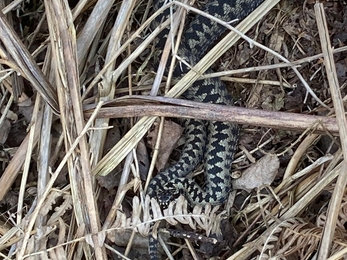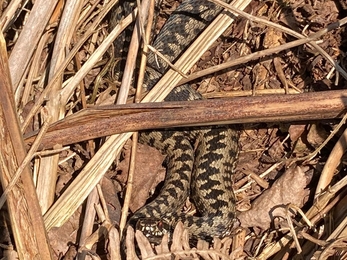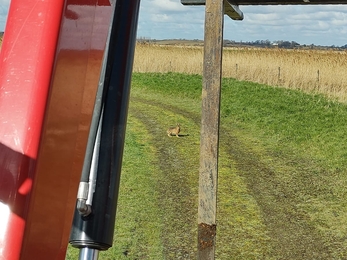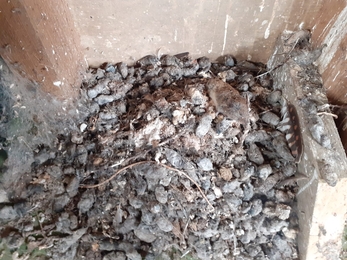Weekly wild news from our reserves, 26 March
Tiger beetle at Redgrave & Lopham Fen - Nick Lingwood
Herons nest in colonies called 'heronries', often in the top of trees, like this pair at Hen Reedbeds. They make their large, ungainly nests out of twigs and lay 3-4 eggs. The young will fledge from the nest after about one and half months. Herons are often seen stood as still as a statue on their long thin legs in shallow waters of ponds and lakes patiently waiting for their next meal to swim by. Make sure you look out for these incredible birds in flight, their slow-flapping wings and long legs held out behind make them hard to miss!
Adders warming up
Ben Calvesbert, Meadows & Heaths Warden, spotted these adders basking in the spring sunshine at Rendlesham Forest this week. The adder can be highly variable in colour, with most males showing a greyish colouration, with the females normally brown. Both sexes have a dark and very distinct zig-zag pattern down the back, and an orangey-red eye. In spring, male adders perform a 'dance' during which they duel to fend off competition to mate. Females incubate the eggs internally, 'giving birth' to three to twenty live young.
Bittern at Hen Reedbeds
Jamie Smith, North East Suffolk Reserves Warden, was lucky to spot this bittern skulking along in front of the viewing platform at Hen Reedbeds. A rare and shy heron, the bittern spends almost all its time hidden away in large reedbeds, where it feeds on eels and other fish. It has wonderfully camouflaged plumage, helping it to blend into the reeds. It can also stand motionless for long periods to avoid detection. During the breeding season, the male bittern 'booms', making a deep, foghorn-like sound which can be heard up to two miles away.
Hairy bittercress
Hairy bittercress is a common, edible weed of rocky areas, walls, gardens and cultivated ground. This tiny plant is currently flowering at Lackford Lakes. Flowering almost all year-round, hairy bittercress self-pollinates. When the seeds are ripe they burst from their pods and can be dispersed up to a metre away in all directions, especially if the plants are shaken by the wind. New seedlings tend to grow in summer and early winter. Wavy bittercress is taller and often found on riverbanks, and in ditches and marshes.
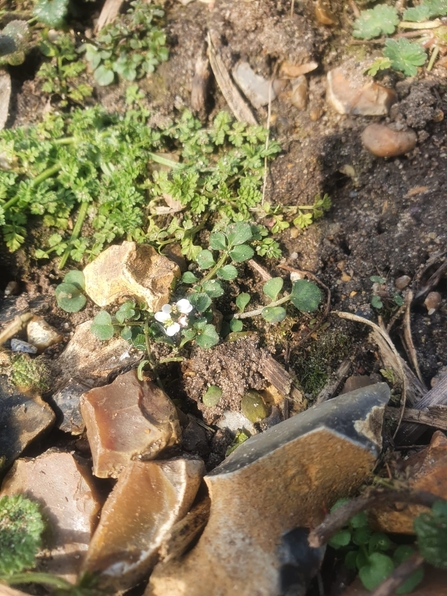
Tiny hairy bittercress at Lackford Lakes – Joe Bell-Tye
Lapwing and marsh harriers displaying
Five lapwings have been displaying at Hen Reedbeds along with marsh harriers sky dancing. The distinctive rounded wings of the lapwing are displayed beautifully when it wheels around; listen out for its 'peewit' calls on grasslands and wetlands. Male marsh harriers perform amazing courtship displays during the breeding season, soaring at great heights then diving towards the ground while performing a series of tumbles.
Green tiger beetle
Volunteer Nick Lingwood spotted this amazing green tiger beetle at Redgrave & Lopham Fen nature reserve this week. The green tiger beetle is a common ground beetle of heathland, moorland, sandy grassland and sand dunes. Often seen in bright, sunny conditions during the spring and summer, the green tiger beetle is a fast, agile hunter, running across the ground to catch its invertebrate prey, including spiders, caterpillars and ants. It is well-equipped to tackle its prey, with a ferocious set of jaws and long legs that give it an impressive turn of speed (it is one of our fastest insects). When disturbed, it will often fly a short distance before running away.
Visitors to the fen this week also heard a bittern booming and saw marsh harriers and a brimstone butterfly fluttering in the sunshine, all lovely signs that spring is on its way.
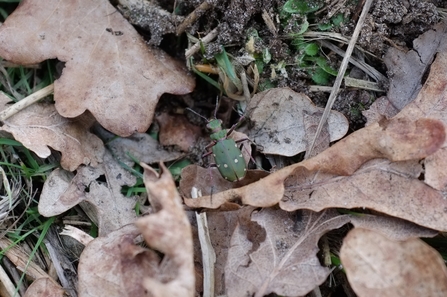
Tiger beetle at Redgrave & Lopham Fen - Nick Lingwood
Hares abound at Trimley Marshes
The anti-predator fencing at Trimley Marshes not only protects breeding waders. Hares are also benefitting and are thriving on the drier areas of this wetland reserve. Charlie McMurray, Trimley Marshes Warden, spotted a group of nine hares together recently. Also at Trimley, the barn owl box has had some unexpected visitors, last year kestrels successfully fledged from the box, then a tawny owl took up residence over winter, and now kestrels are taking an interest again, as indicated by the presence of a kestrel wing feather and kestrel pellets beneath the box.
Common whitlow grass
Warden David Stansfeld admired this common whitlow grass flowering at Knettishall Heath this week. Whitlow grass is not a grass at all but a very small white crucifer which flowers in the early spring or late winter. It is one of those plants you can see on stony ground early in the year but which, by May or June has completely disappeared without trace. As with many crucifers the key to identification lies with the combination of fruit shape, leaf shape and flower.
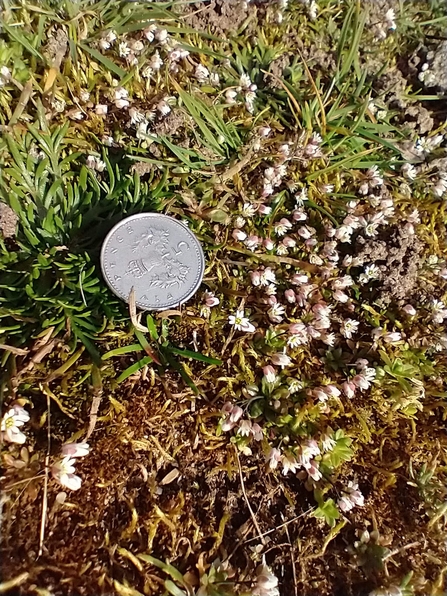
Common whitlow grass at Knettishall Heath - David Stansfeld


